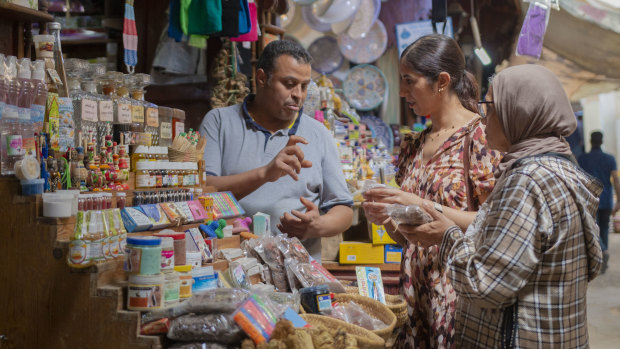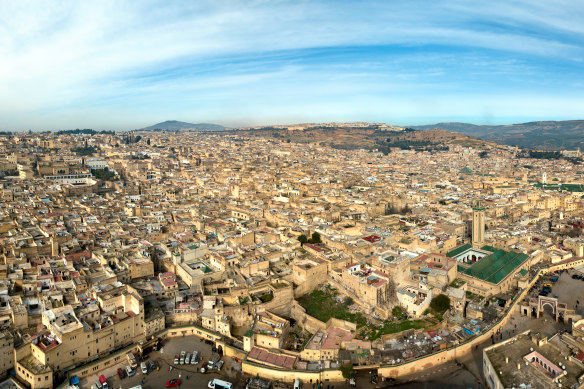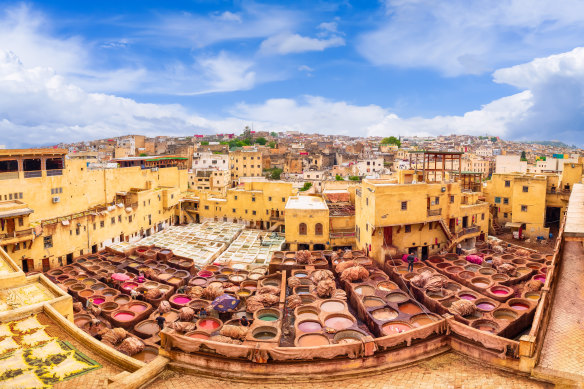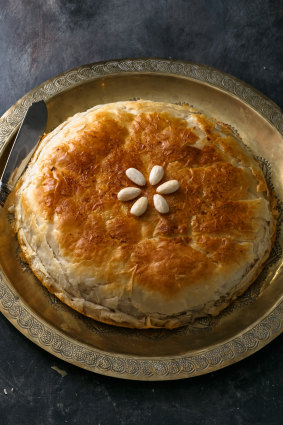This was published 1 year ago
The world’s largest car-free urban area is a maze
By Anabel Dean
“You can forget the maps, the guidebooks, the phone,” says Meryem Ameziane. “If you’re not born in the medina, you will not find your way. You will be lost.”
Ameziane is trying to make me feel better. Yesterday, I was hopelessly adrift in the beguiling labyrinth of 10,000 twisting alleyways only passable on foot, dazzled and frazzled by the dead-ends and doglegs in the largest car-free urban area in the world.

Marketing in the medina.
Today, my scholarly companion is leading me back into the maze, magenta hijab fluttering like a magnificent banner through fortified passageways sometimes so intimate we barely fit past two loaded donkeys.
So many questions about Fes, the oldest imperial capital of Morocco, just north of the Middle Atlas Mountains, would go unanswered were it not for Ameziane.
“I was born here 35 years ago and I’m still discovering new corners of the medina, though I’ve been a tour guide for almost 10 years,” she says, slipping sylph-like past a cart piled high with gas cylinders.

The Medina is a labyrinth of 10,000 twisting alleyways only passable on foot.Credit: iStock
“As a kid, my mother continually warned me not to stray but I got lost all the time, so I would say the name of the neighbourhood where I lived and someone would help. A shopkeeper would tell a passer-by ‘this little girl needs to go home so please walk her there’ and it would just happen.”
The rhythm of life exists as it always has in the World Heritage-listed site: time marked out by the muezzin call to prayer and the shifting shadows of sun across buildings dating back to the ninth century.
“Watch your steps,” says Ameziane, nudging though the main thoroughfare of Talaa Kebira, and then Talaa Seghira, two main arteries running roughly east from Bab Bou Jeloud gate to converge in Place An Nejjarine. She’s speaking of hidden splendours behind hugely heavy doors with big brass knockers.
“We keep everything simple, kind of modest and mysterious from the outside, but beautiful when you walk within.” It is the way of Islam.
At the green-tiled Medersa Bou Inania, the most architecturally refined of Fes’s theological colleges, built in 1357, an interior courtyard is a masterpiece of elaborate mosaic (zellij) tilework, cedar lattice screens and extraordinarily beautiful carved plaster. At the Nijjarine Museum, a restored early 18th-century inn once used by camel caravans, the travelling merchant rooms now display the finest woodwork, prayer beads and musical instruments from across Morocco.
You’d probably never find the Chouara Tannery on your own. Access to the largest medieval tannery in the medina is gained by walking through a leather shop and up a staircase onto an open terrace where a sheaf of fresh mint, shoved under the nostrils, fails to mask the acrid repellence of pigeon poo blended with pomegranate to tan hides in huge ink pots beneath our feet.

Looking down at the tannery in the Fes medina.Credit: iStock
The world’s largest medieval medina is a potent mix of sights and sensations, the nauseous and the sensual, a feast for all senses and even better savoured on a food tour. We make a plan to meet again on the following day but five hours after we part, a 6.8-magnitude earthquake hits the High Atlas mountain range, about 560 kilometres from Fes, and life changes irrevocably for thousands of Moroccans.
As if a dream, the upheaval that traumatises the country merely rattles my bed posts. Ameziane materialises at the riad, subdued and exhausted; she’s spent the night fielding critical information to family and friends.
“You don’t need to stay with me today,” I say. “No,” she replies. “We will continue.” Inshallah.
Hooves are clattering on cobblestones behind us. “Balak,” she says. “Be careful.” She’s putting her best foot forward, offering scholarly insights into artisanal workshops and medieval hovels and green-roofed mosques with tiled minarets, places where activity and repose exist in equal measure. Men in djellabas shuffle in slow motion between spice and pottery pyramids. Small boys play soccer in cool shadows.
We move with the tap-tapping of the copper and brass forges, past the hung-low beams that stop mules wandering into sacred sites, into the heart of the food quarter. The fly-spotted camel head and live chicken slaughterhouse slow progress. There’s no hurry. A sheep head is being charred over hot coals. “The cheek is the best bit,” says Ameziane, “but it’s not ready to eat yet”.
A woman is making wafer-thin warqa (filo pastry) and a man is selling freshly made feta. What should we taste first in a pleasure garden of date, almond, olive, lemon and peach? There’s time for a lingering glass of mint tea and an irresistibly syrupy pastry. We try the grilled skewer of herby lamb and, the local favourite, a thick broad bean soup with a drizzle of oil and a sprinkling of cumin (bissara).

Food for thought – Moroccan bastilla on a copper plate.Credit: iStock
I wonder if we might return to the restaurant with white walls and high ceilings where we had earlier demolished a savoury, sweet pie traditionally made from pigeon. Bastilla, a fassi specialty, might be one of the most languidly memorable experiences of my life.
Where was that oasis of cushioned calm? No idea. Memories are lost forever in the ancient medina of Fes.
The writer was the guest of Inclusive Morocco.
THE DETAILS
TOUR
The Hidden Medina and the Souks Tasting Trail are tours arranged by Inclusive Morocco, a company that uses local guides and tailors itineraries for unique, culturally immersive adventures in Fes, and throughout Morocco. See inclusivemorocco.com
Sign up for the Traveller Deals newsletter
Get exclusive travel deals delivered straight to your inbox. Sign up now.